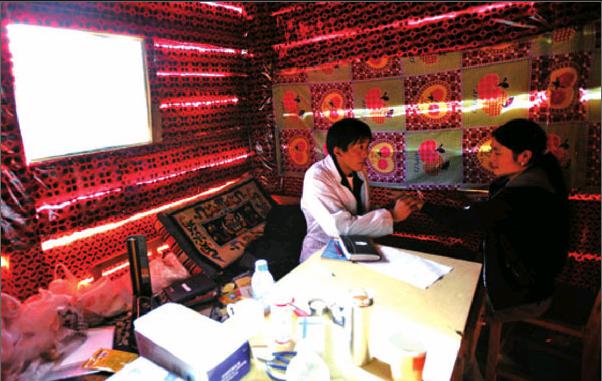MEDICINE FROM THE PLATEAU
2015-10-07ByYuanYuan
By+Yuan+Yuan

Born into a family of traditional Tibetan doctors in 1966, Puqung first began to serve as a doctor in his village in Baxoi County, southwest Chinas Tibet Autonomous Region, at the tender age of 15. Two years earlier, Puqung had commenced his study by memorizing the Four Volumes of Medicine(FVM), regarded as the most systematic and complete book on Tibetan medicine.
By 24, he had become a chief doctor at Qamdo Tibetan Medicine Hospital in east Tibet, a position he holds to this day.
Every day, Puqung treats about 80 patients. “Some even come to my home on weekends for treatment,” he said. He often uses a bamboo stick to stir patients urine samples—a diagnostic method unique to Tibetan medicine.
“There are more than 300 fixed prescriptions in Tibetan medicine and they need to be adjusted according to different patientsconditions,” said Puqung.
A long history
With a history stretching back more than 2,300 years, Tibetan medicine is one of Chinas most storied and influential medical disciplines. In 2006, it was awarded the status of national intangible cultural heritage. Last year, China filed an application to have Tibetan medicine inscribed upon the UNESCOs intangible heritage list, giving it a nudge toward gaining global acknowledgement.
Consisting of 156 chapters, the FVM was first published in 1546. “In the past, one was required to recite the whole volume from memory if he wished to be accepted by a master as an apprentice,” said Renwang Cering, Vice President of Beijing Tibetan Medicine Hospital.
Born in 1962 in Lhoka Prefecture, Tibet, Renwang Cering studied Tibetan medicine for 15 years before becoming a doctor at Tibetan Medicine Hospital in Lhasa in 1995. Later, he was transferred to Beijing Tibetan Medicine Hospital, founded in 1992.
“In the 1990s, only a select few people would come and visit Tibetan medicine doctors, now we see many more patients coming in for treatment,” he said.
But Renwang Cering also admitted that many patients who come for Tibetan medicine are transferred from other hospitals.“Some are diagnosed with terminal diseases and see no hope with Western medical treatment,” he said. “They bet on the possibility that Tibetan medicine might have some mysterious power and wish for it to create a miracle.”
For many, the geographic specificity of Tibetan medicine makes the possibility that it might be able to help their condition quite remote. “I think Tibetan medicine is more suitable for people living in Tibet as the altitude is quite high and oxygen is so scarce,”said a 35-year-old Beijing resident surnamed Xie. “I wonder whether or not the herbs grown in that climate and environment can be used effectively on patients in other places.”
Yanggar, a Tibetan medicine doctor who is studying at Harvard University, also on occasion finds himself at a bit of a loss as to how exactly to employ Tibetan medicine in places outside of the region.
Yanggar once used Tibetan herbs on an American patient, who went on to show symptoms of an allergy after two days. “These are very common and widely used herbs in Tibet and I never encountered anybody who was allergic to them,” Yanggar said. “I couldnt figure out the reasons for the allergy and I have not dared to treat patients since then.”
“Quality evaluation in Tibetan medicine lags far behind other disciplines,” said Nie Lijuan, a professor at the School of Medicine at Tibet University in Lhasa. Recently, medical experts in Tibet announced a quality evaluation standard for Mirabilis himalaica, an endangered herb used in Tibetan medicine to promote urination and treat many kidneyrelated diseases. The herb grows only at a range between 700 and 3,300 meters above sea level.
“They are endangered owing to the very specific conditions needed for their growth but are widely used in clinical practice,” Nie said.“During research, we established an evaluation method by combining both component measurement and the analysis of infrared spectroscopy. It is the first quality control standard for rare Tibetan medicinal herbs.”
Exporting Tibet
Official statistics show there are now more than 30 Tibetan medical institutions, 1,364 beds and 1,901 permanent Tibetan medicine doctors in Tibet.
In 2008, the Agriculture and Animal Husbandry College was established in Tibet University. Between 50-60 different kinds of medicinal herbs have been cultivated at the college for large-scale production so as to guarantee future supply.
In 2012, the Institute of Tibetan Medicine in Tibet launched a marketing course for Tibetan medicine and enrolled many students of Han ethnicity. “We have more than 30 students in this class and aim to cultivate more professionals to promote Tibetan medicine in more places across China and the world,” said Nyima Cering, head of the institute.
Tibetan medicine now has become one of the major pillars of the regions economy.
Another Nyima Cering, a farmer who grows medicinal herbs in Quxu County, has seen a boom in his business.
“Every year, I can earn an average income of about 350,000 yuan ($54,950) from cultivating Tibetan medicinal herbs,” he said.
Cheezheng Group, a leading Tibetan medicine manufacturer based in Gansu Province, which lies adjacent to Tibet, has a broader goal. Established in 1993, its medicines are sold in 36 countries and regions dispersed across North America, Southeast Asia and Europe.
Now it is planning to cooperate with Walmart Pharmacy to expand its market share in the United States.
“This is part of the companys global market expansion program, said Lei Jufang, Board Chairman of the group. “To cooperate with Walmart Pharmacy, we have had our products approved under the National Drug Code standards so we can sell them in the U.S. market.”
Cheezheng is applying for certification under the Good Manufacturing Practice Regulation overseen by the Australian Therapeutic Goods Administration. In addition, it has already signed a cooperative agreement with Hong Kong Watsons Chemist Group to sell its products in Watsons personal care stores in Hong Kong.
“One of our targets is the mainstream medicine market, rather than the traditional stalls on the streets,” said Lei.
